EX Management Programs Within Large Firms
To understand the present state of employee experience (EX) management efforts, we surveyed 250 HR leaders at large companies.1 The results of this survey show that:
- Companies plan to increase their focus on EX. Eighty percent of respondents expect their organizations to focus more on improving EX over the next 12 months than they did in the previous year and only 5% say they plan to focus on it less
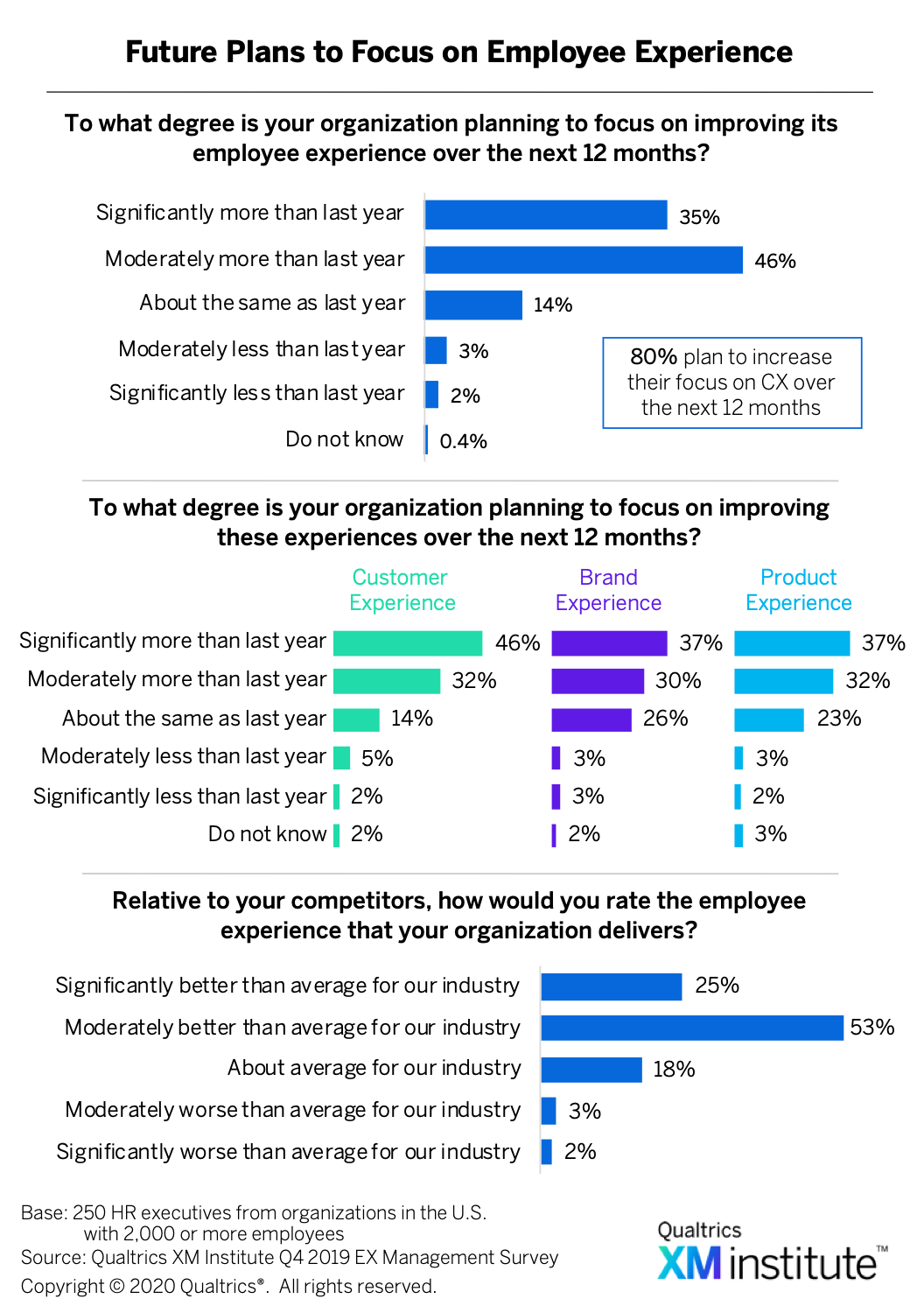 . Nearly the same percentage also plan to focus more on CX improvements in the next year.
. Nearly the same percentage also plan to focus more on CX improvements in the next year. - Most believe they deliver above-average EX. More than three-quarters of respondents rate their organization’s EX as moderately or significantly better than their industry average. Only 5% of respondents say they deliver EX that is moderately or significantly worse than industry average.
- Two-thirds of executives prioritize taking action on employee feedback. Ninety percent of respondents measure employee engagement at least annually and 66% say their executive teams make it a priority to act on the results
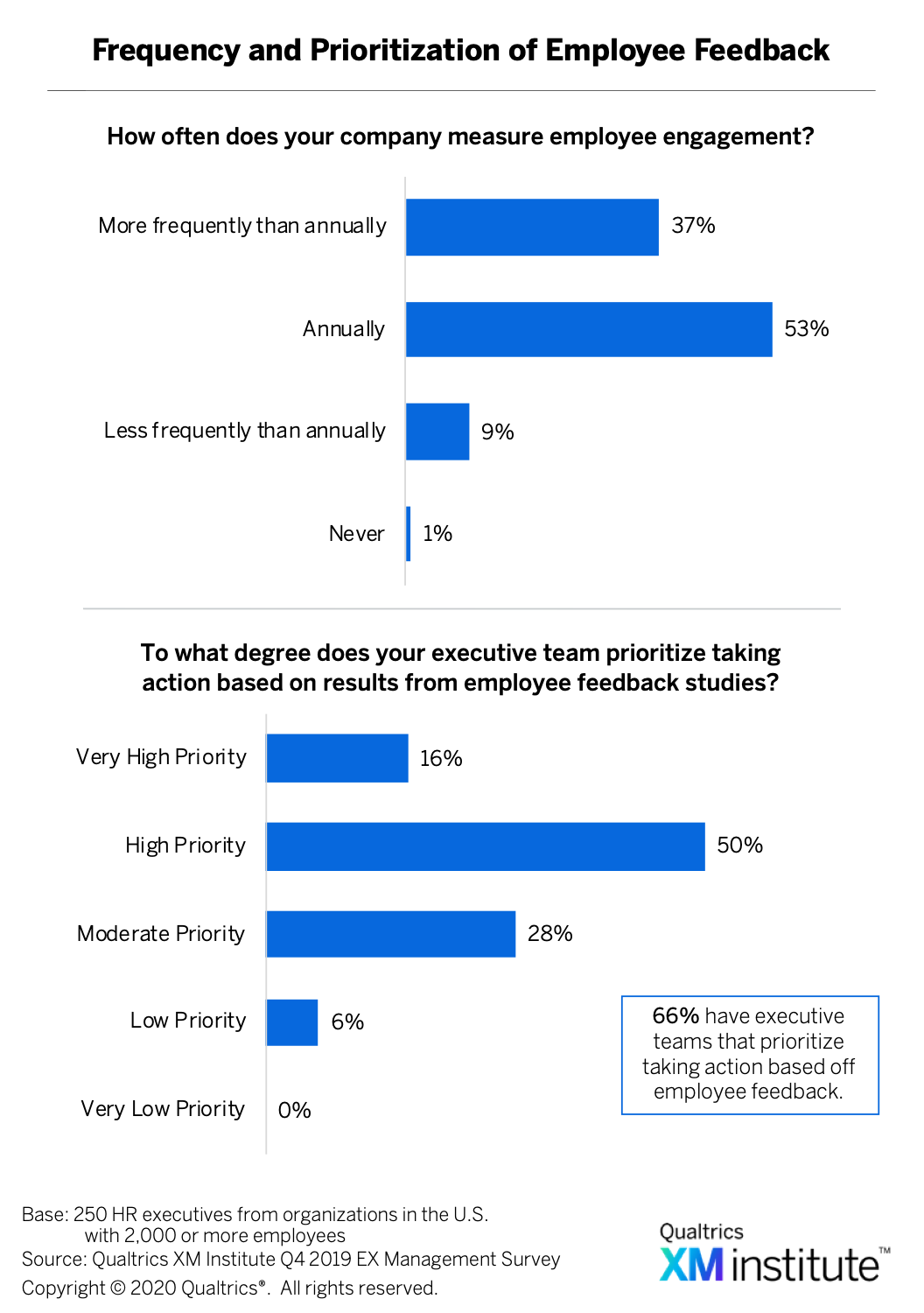 .
. - Employee surveys are rated highest for feedback effectiveness. When we asked respondents to evaluate how effectively they use different types of feedback, employee engagement and employee pulse surveys received the highest percentage of responses. Effectiveness in taking action based on employee feedback insights received the lowest percentage with only 23% saying it was used very effectively
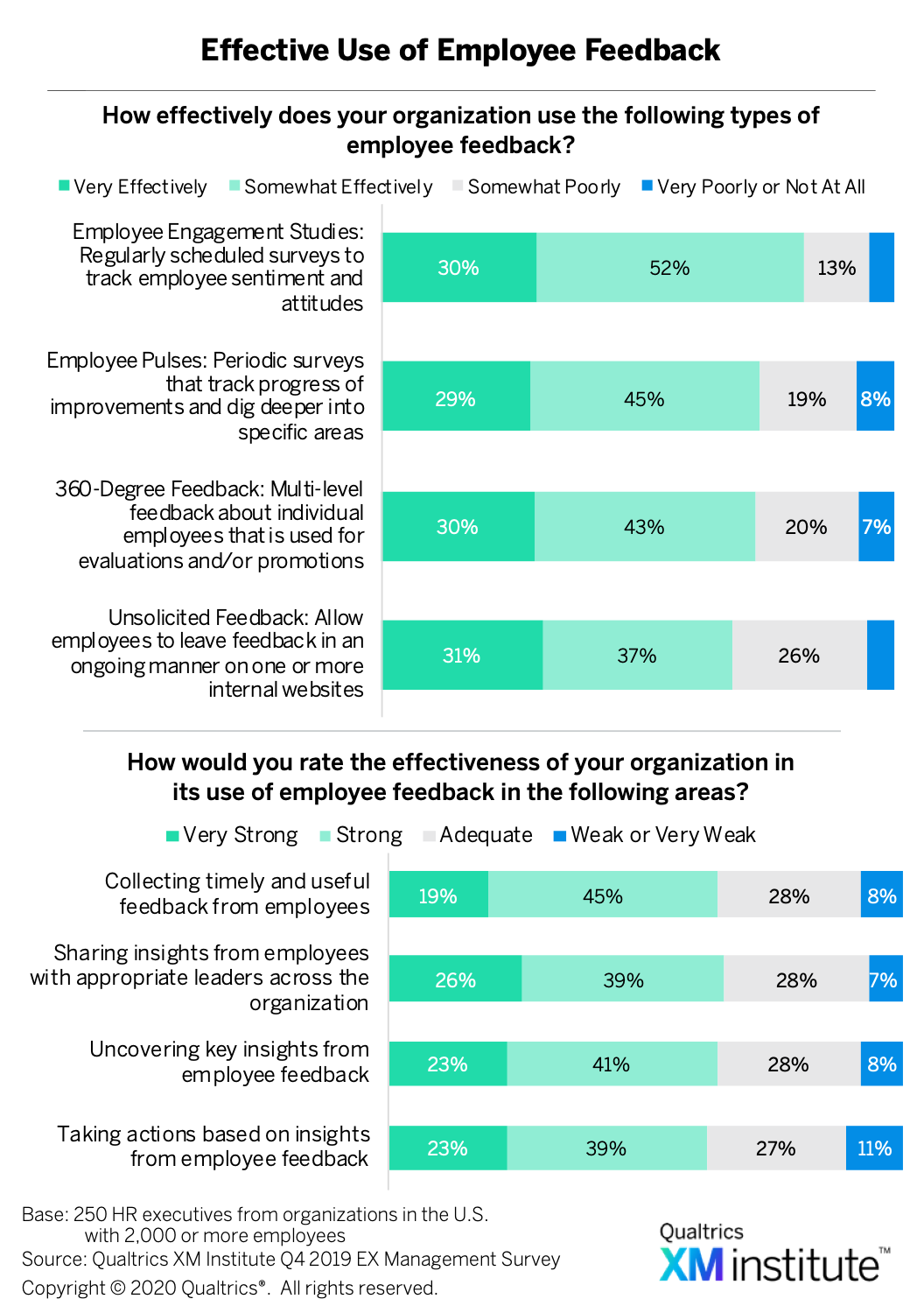 .
. - Feedback on training experiences is collected most frequently. Seventy-six percent of respondents say they collect employee feedback after training and development experiences
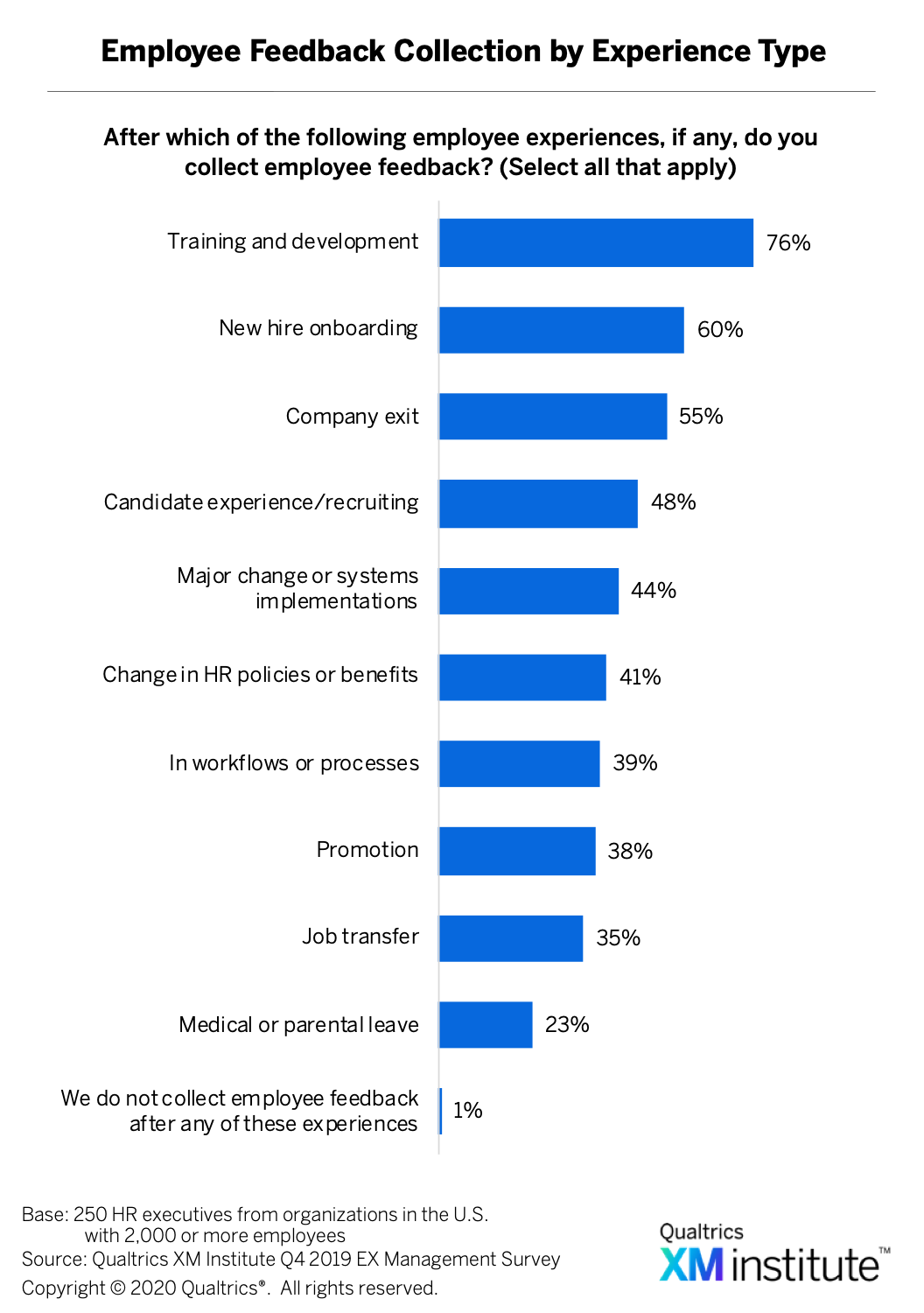 . New hire onboarding, company exit, and candidate experience/recruiting round out the experience types for which organizations most frequently request feedback.
. New hire onboarding, company exit, and candidate experience/recruiting round out the experience types for which organizations most frequently request feedback. - Training and development experience improvements are the strongest. Seventy-one percent of respondents report their effectiveness at making ongoing improvements to the training and development experience as “very strong” or “strong”
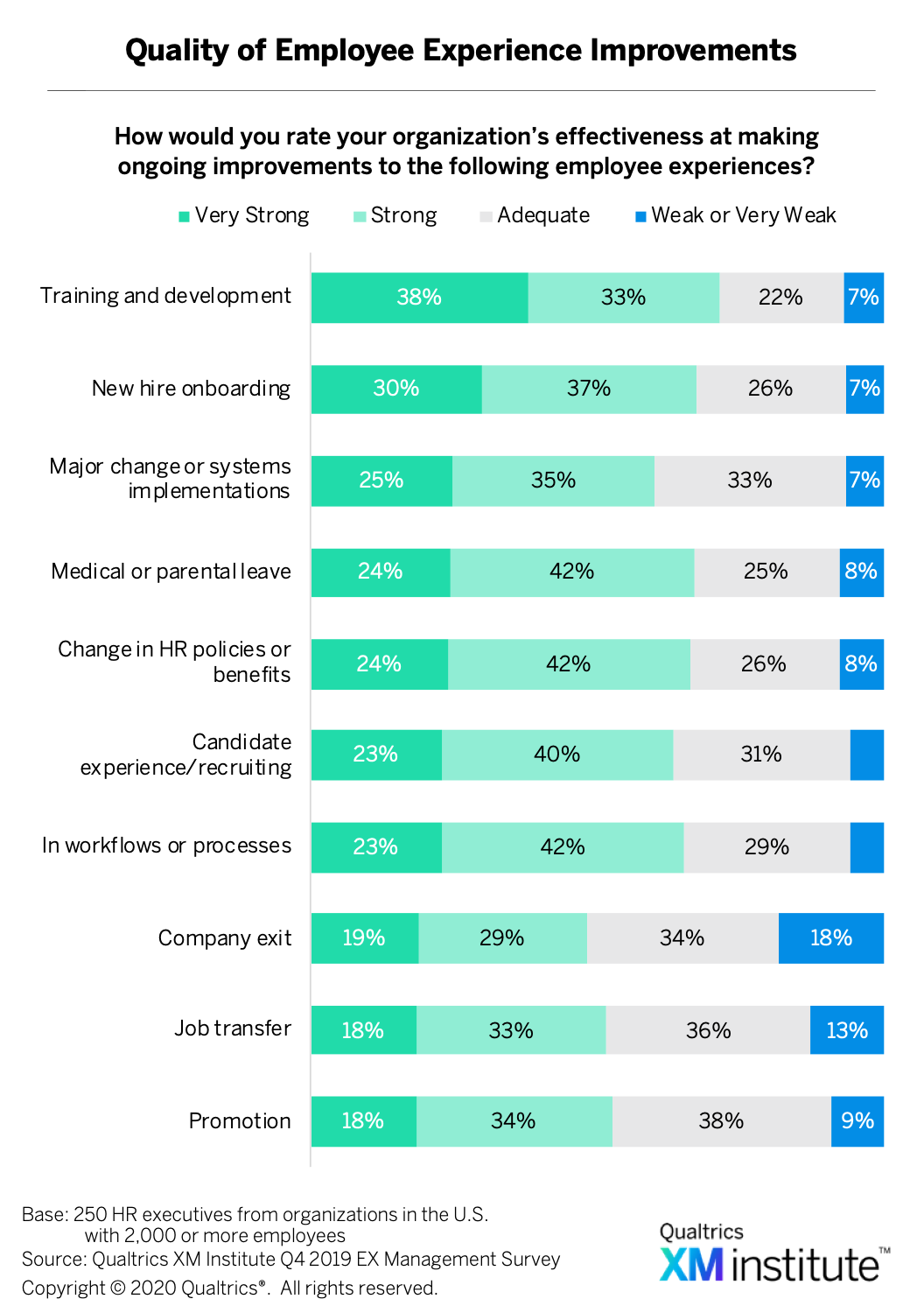 . In contrast, only 48% of respondents rate their effectiveness at making ongoing improvements to the company exit experience in the same way.
. In contrast, only 48% of respondents rate their effectiveness at making ongoing improvements to the company exit experience in the same way. - Most CEOs champion EX efforts. Seventy percent of respondents say their CEO or equivalent leader is a strong or very strong champion for employee experience, while only 2% responded that their CEO or equivalent leader is not at all a champion
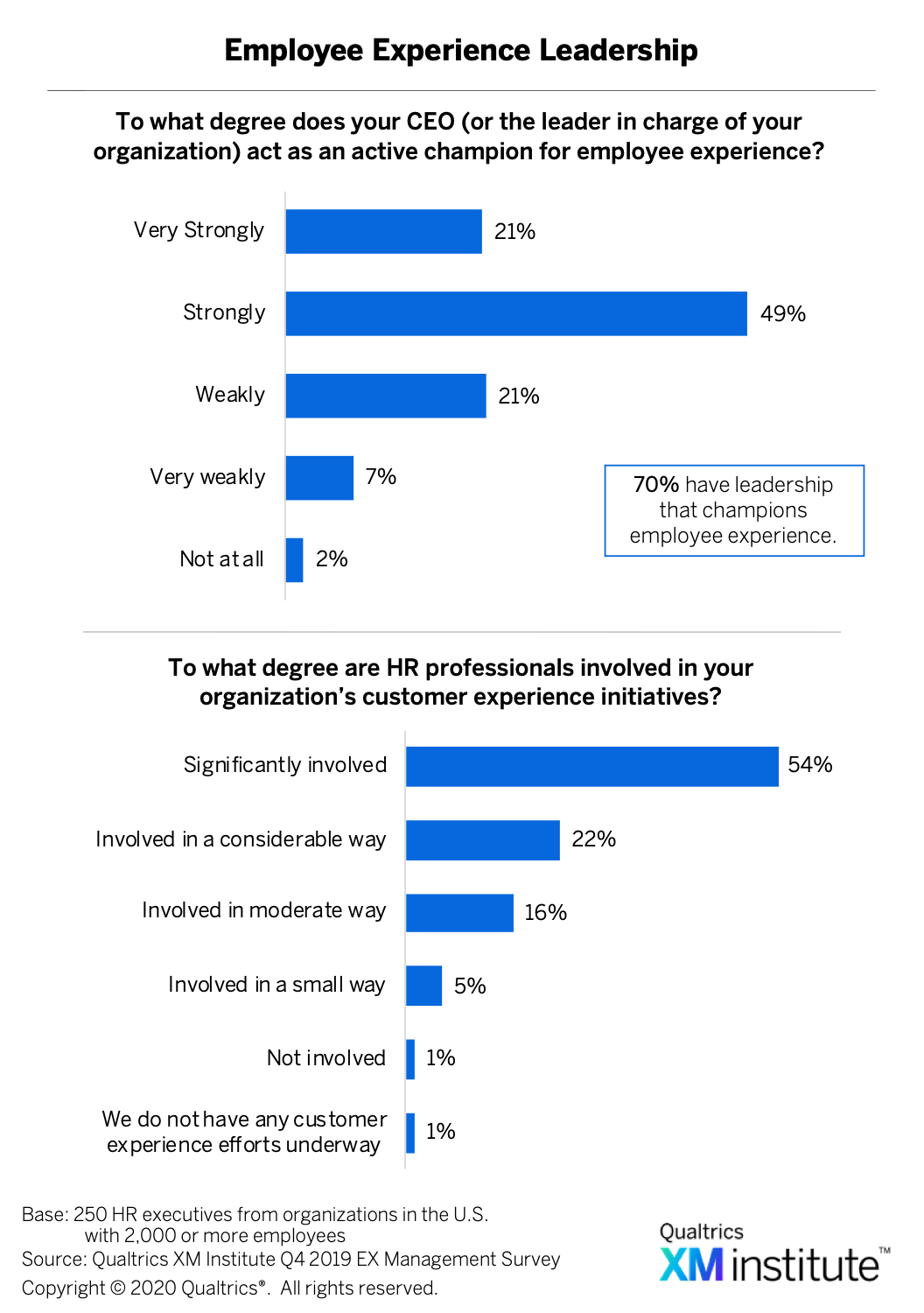 .
. - Inconsistent leadership buy-in is a top obstacle to EX success. The most frequently reported obstacle to EX efforts is inconsistent buy-in among leadership team with 33% of respondents selecting this obstacle
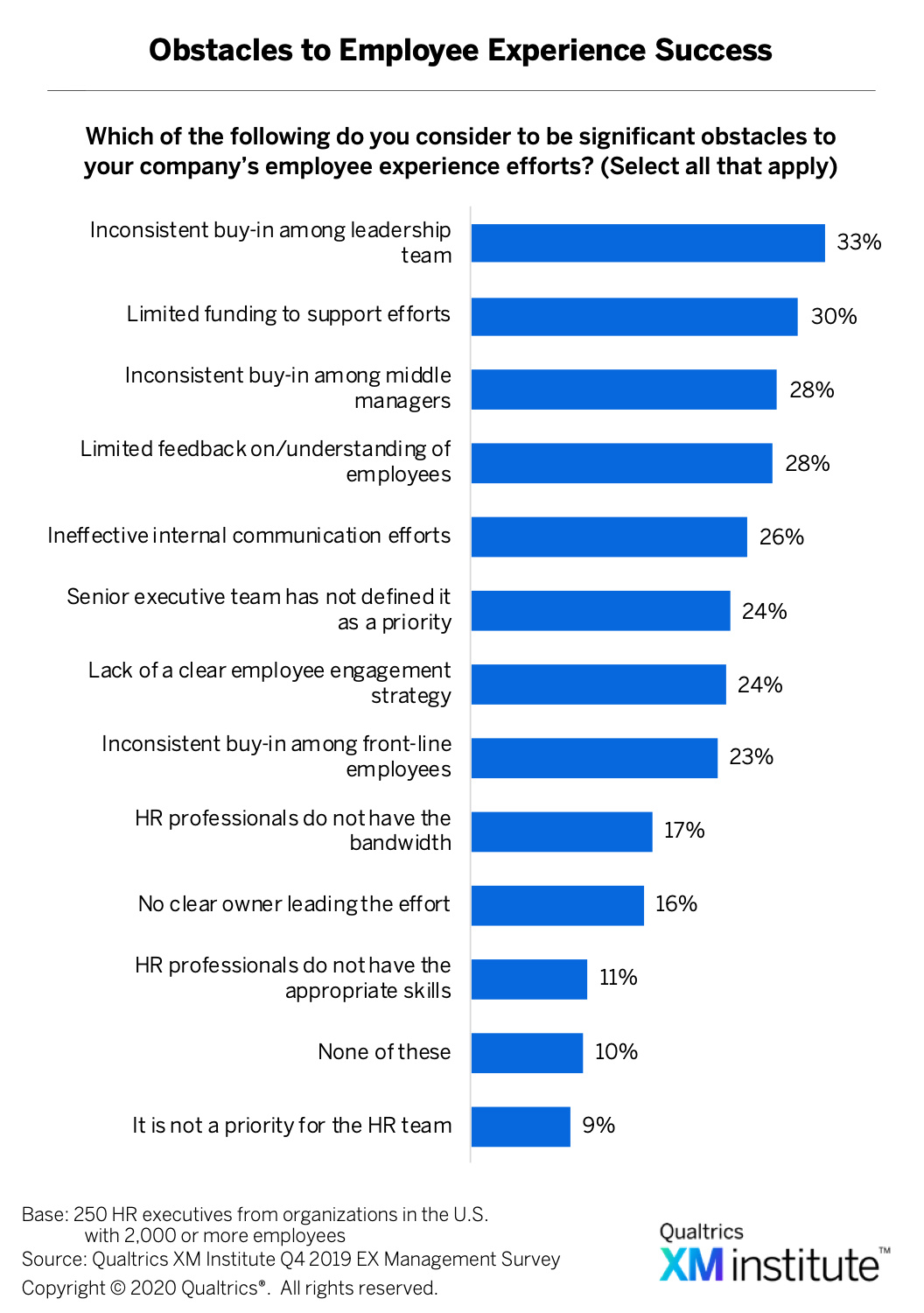 . The next most frequently reported obstacles are limited funding to support efforts (30%) and inconsistent buy-in among middle managers (28%).
. The next most frequently reported obstacles are limited funding to support efforts (30%) and inconsistent buy-in among middle managers (28%). - Coordination between CX and HR teams is low. A minority of respondents say employee-focused CX activities are done jointly by CX and HR groups
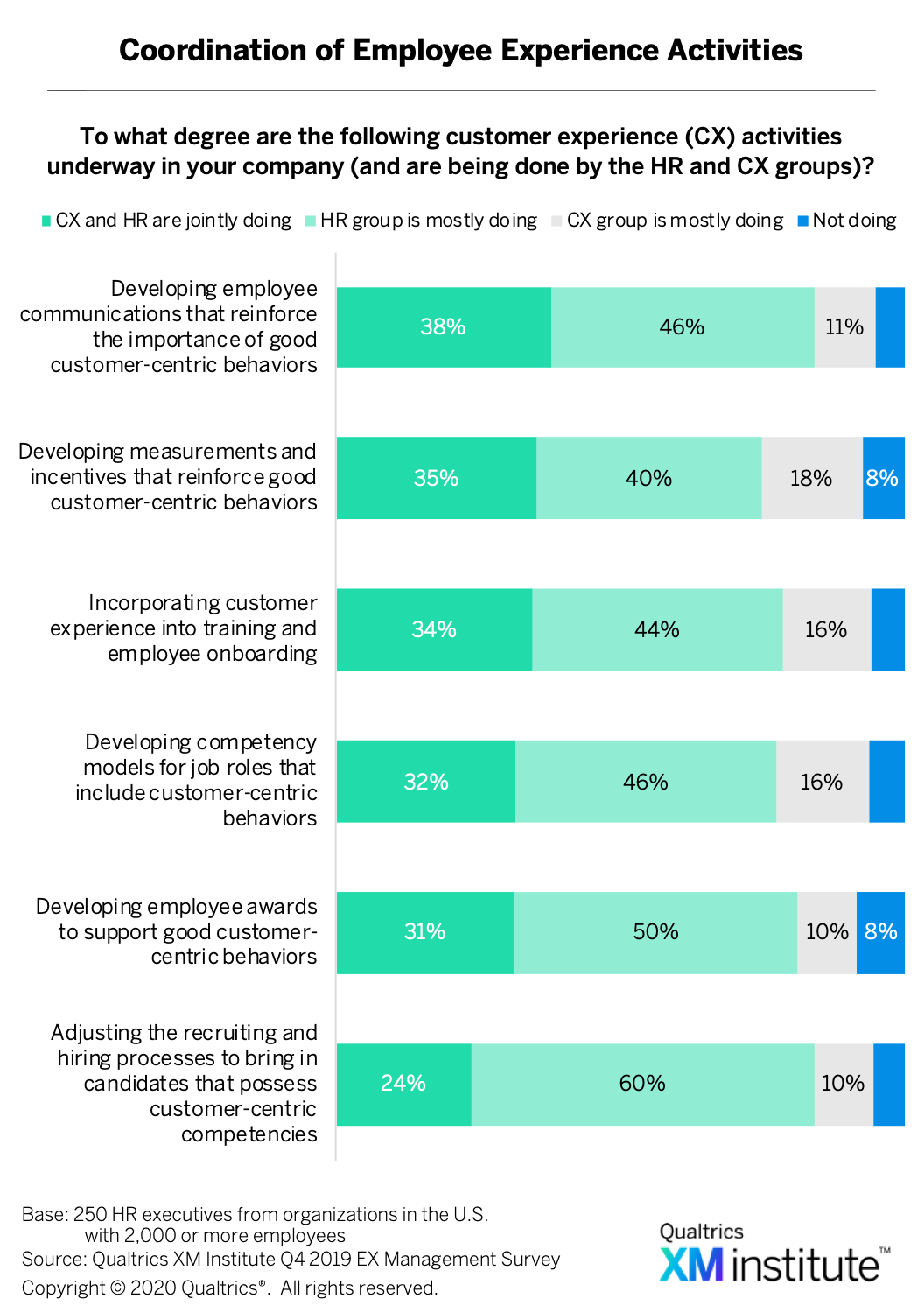 . For example, 38% of respondents say that CX and HR jointly develop employee communications that reinforce the importance of good customer-centric behaviors and only 24% report HR and CX working together to bring in candidates with customer-centric competencies.
. For example, 38% of respondents say that CX and HR jointly develop employee communications that reinforce the importance of good customer-centric behaviors and only 24% report HR and CX working together to bring in candidates with customer-centric competencies.
Assessing the Six XM Competencies
The Qualtrics XM Institute has identified six XM Competencies — LEAD, REALIZE, ACTIVATE, ENLIGHTEN, RESPOND, and DISRUPT — that organizations must build in order to deliver consistently positive, targeted experiences to their key stakeholders 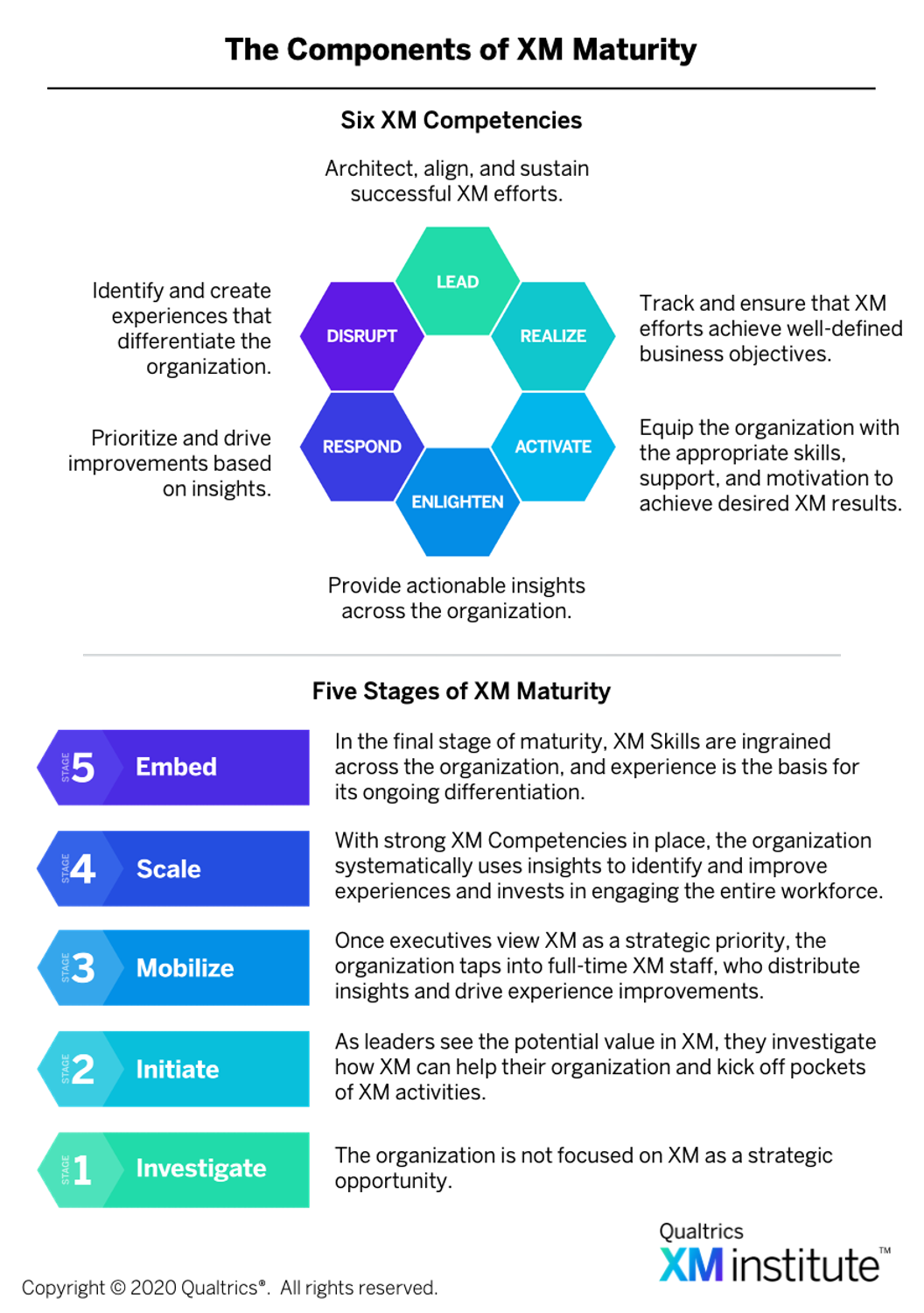 ,
, 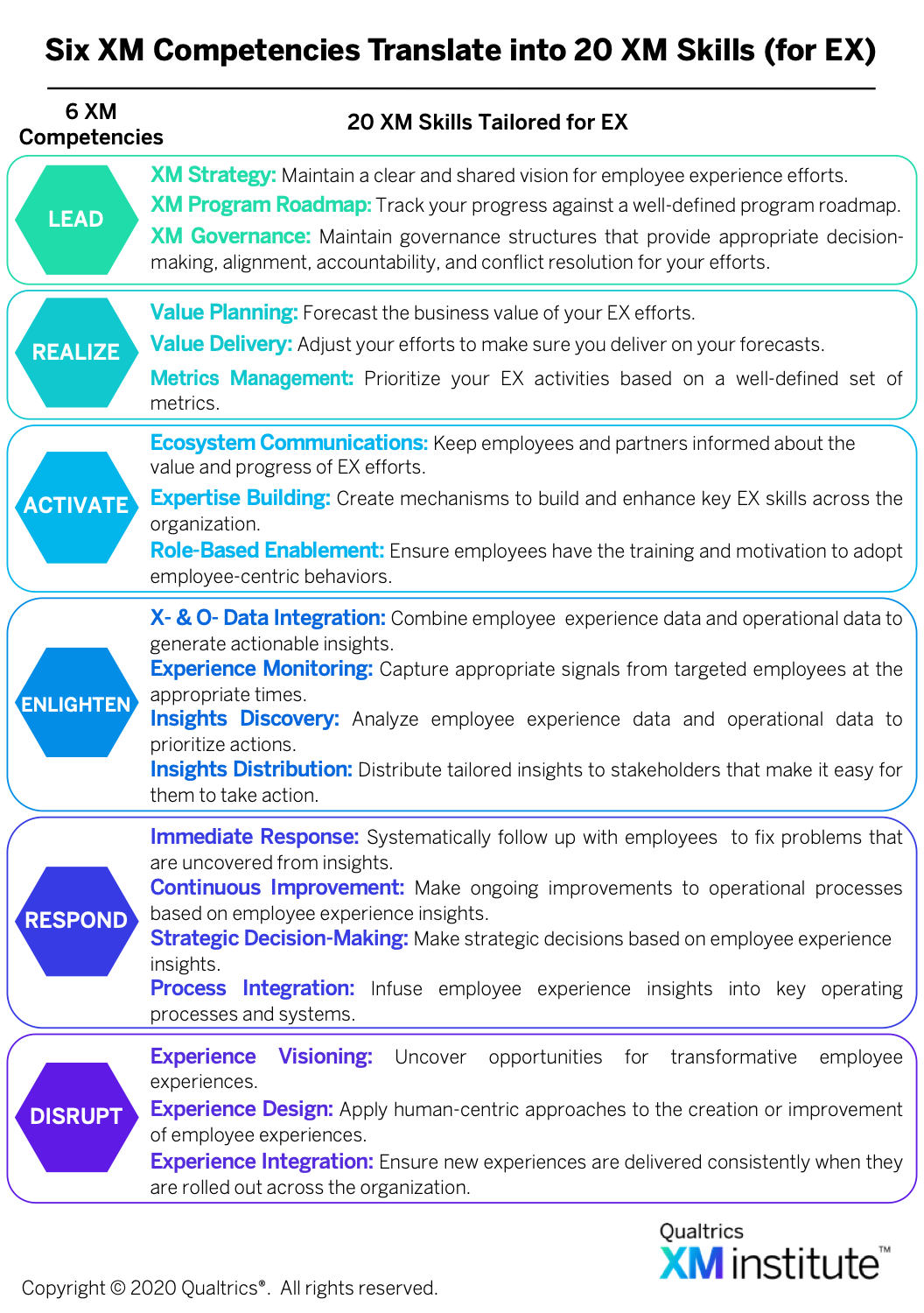 .2 As organizations master the Six XM Competencies, they will evolve through five stages of XM maturity. In our survey, we asked respondents a series of questions from the EX version of our XM Competency & Maturity Assessment
.2 As organizations master the Six XM Competencies, they will evolve through five stages of XM maturity. In our survey, we asked respondents a series of questions from the EX version of our XM Competency & Maturity Assessment 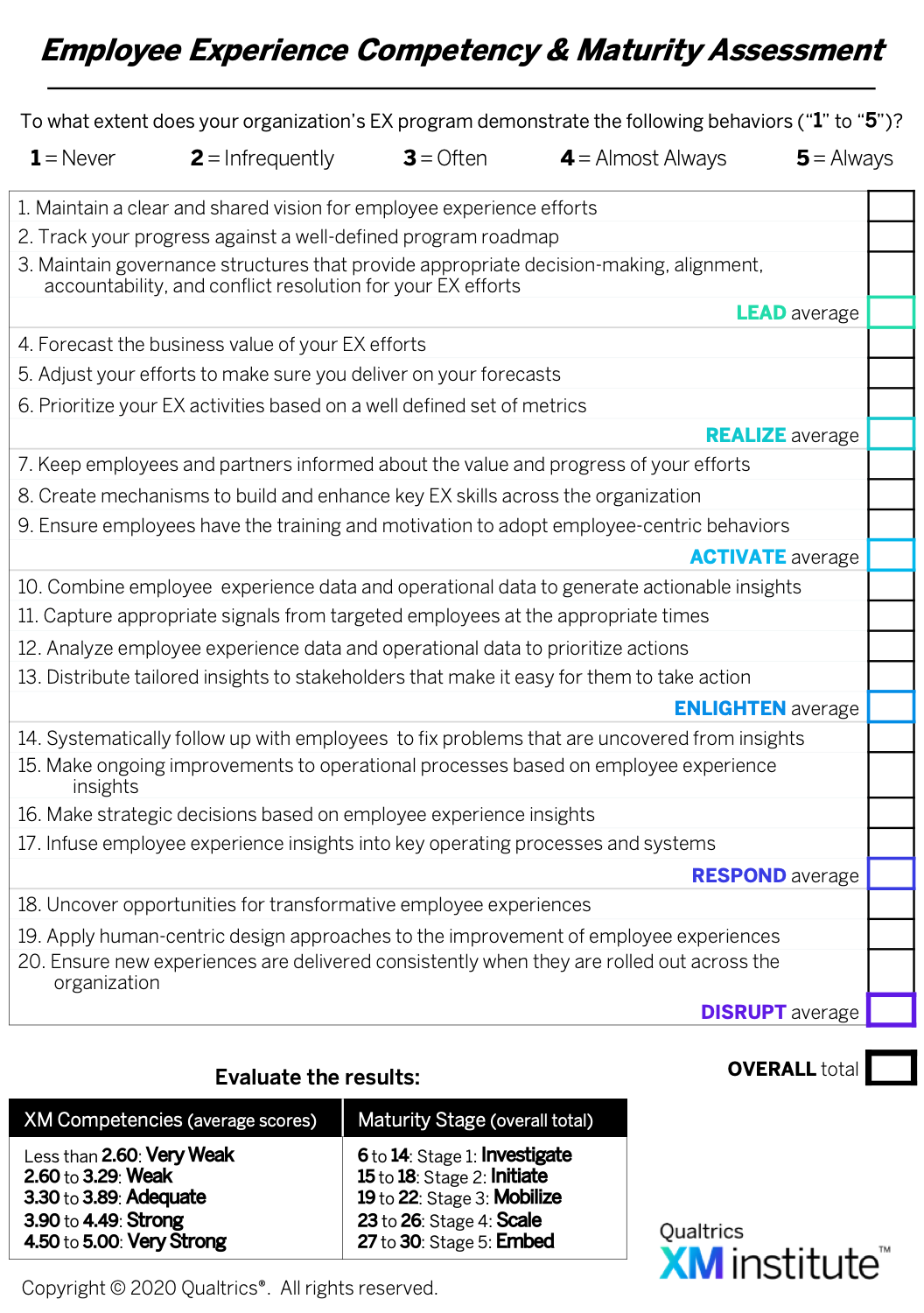 . The results of this assessment show:
. The results of this assessment show:
- Most companies have established EX programs. Over half of respondents place in the third and fourth maturity stages
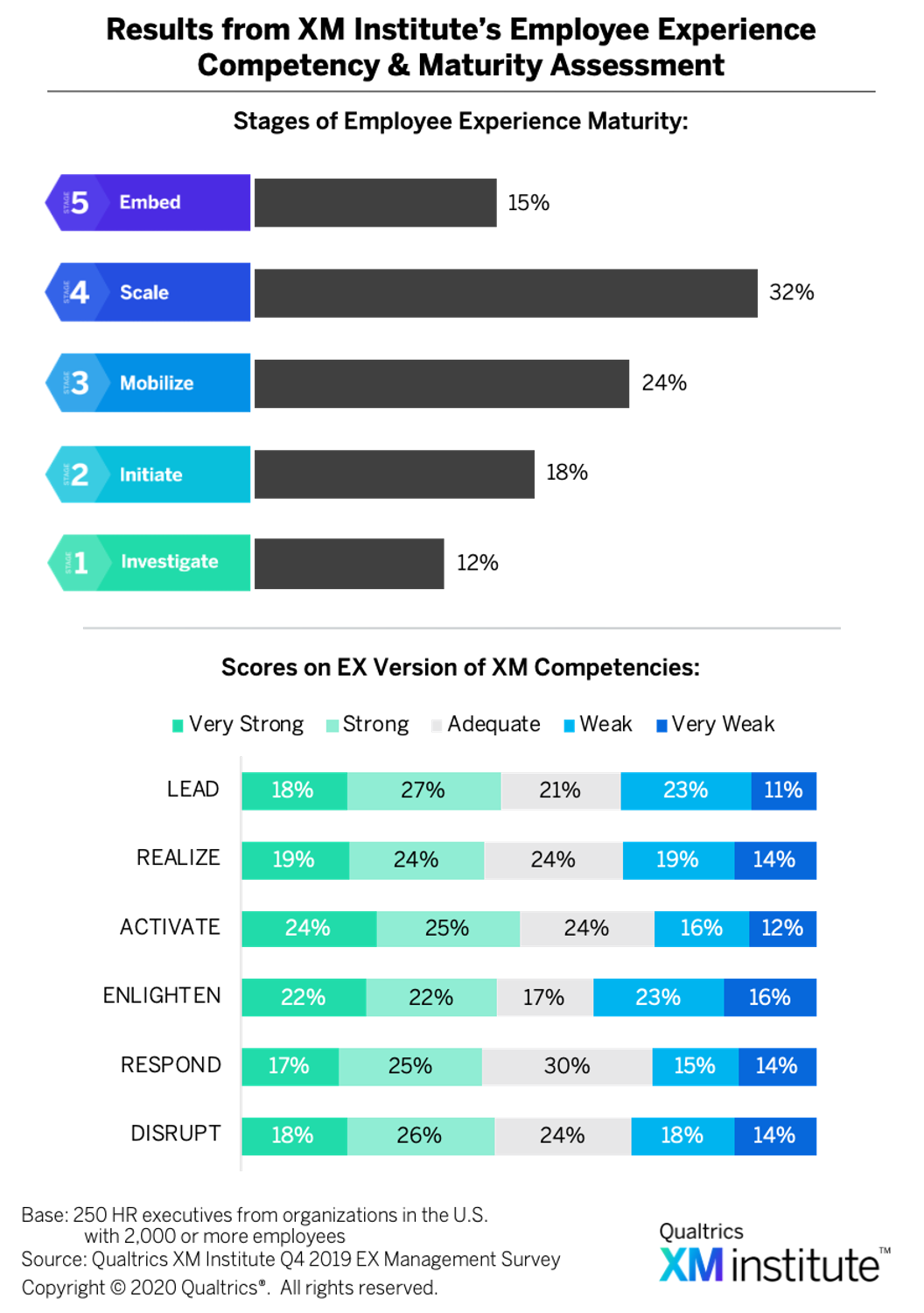 .
. - EX development is consistent across the Competencies. Across each of the Six Competencies, fewer than half of respondents received ratings of “strong” or “very strong.” Respondents performed best in ACTIVATE, with 49% rated as “very strong” or “strong,”
Comparing EX Leaders and Laggards
How do EX leaders differ from their less mature peers? To address this question, we split the respondents into two groups based on EX Competency & Maturity Assessment scores. We split the respondents into two groups based on their overall maturity scores and labeled companies with scores of 22.6 or above as “EX Leaders” and companies with scores below 22.6 as “EX Laggards.” When we compared results between these two groups, we found that EX Leaders:
- Focus more on XM and perform better. EX Leaders are more likely to increase their focus on the four experiences (employee, customer, product, and brand) over the next 12 months
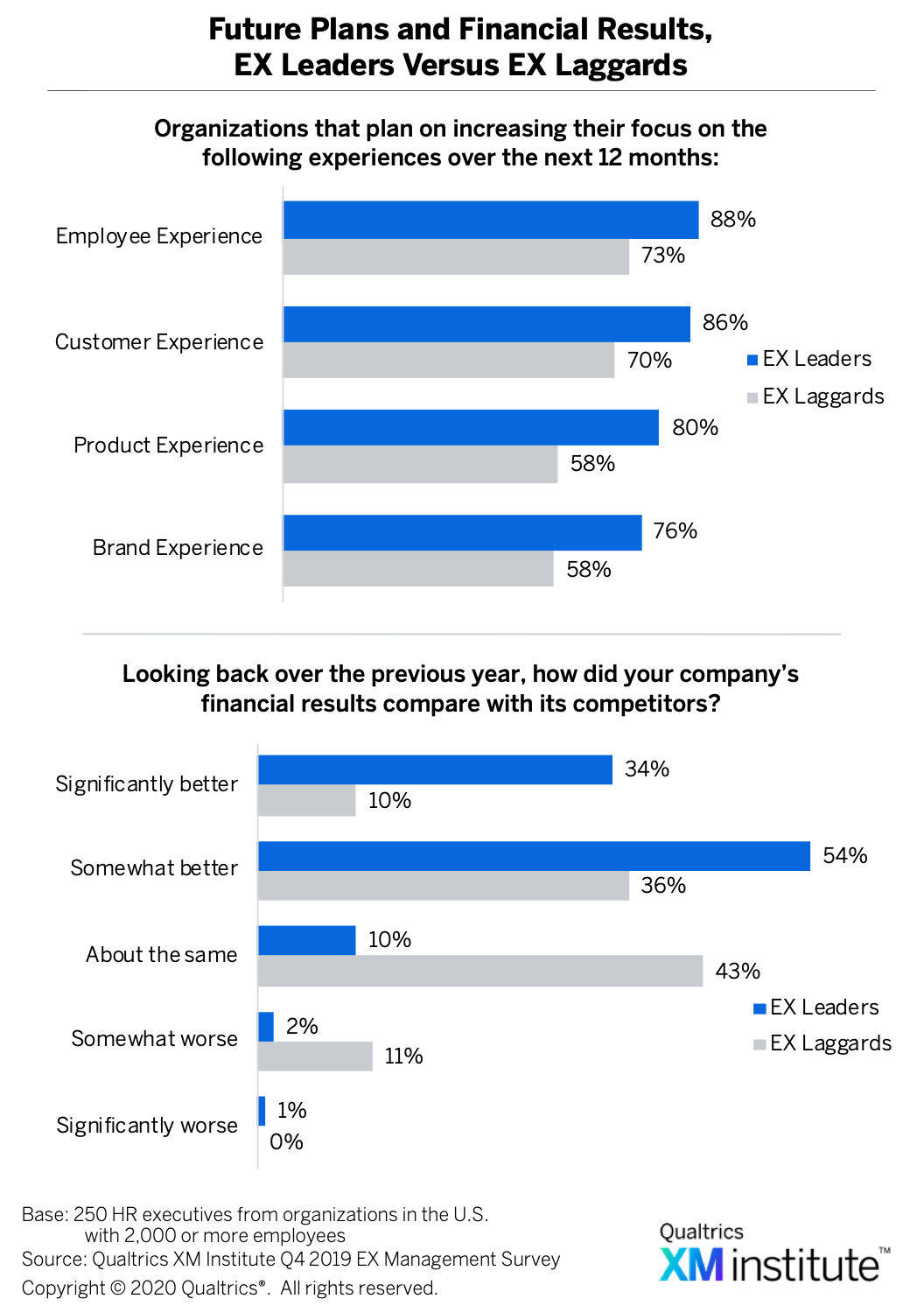 . Eighty-eight percent of EX Leaders say their company’s financial results were “significantly better” or “somewhat better” compared to their competitors, whereas only 46% of EX Laggards say the same.
. Eighty-eight percent of EX Leaders say their company’s financial results were “significantly better” or “somewhat better” compared to their competitors, whereas only 46% of EX Laggards say the same. - Deliver better employee and customer experiences. Thirty-nine percent of EX Leaders report their employee experience is “significantly better” than average in their industry compared with 10% of EX Laggards
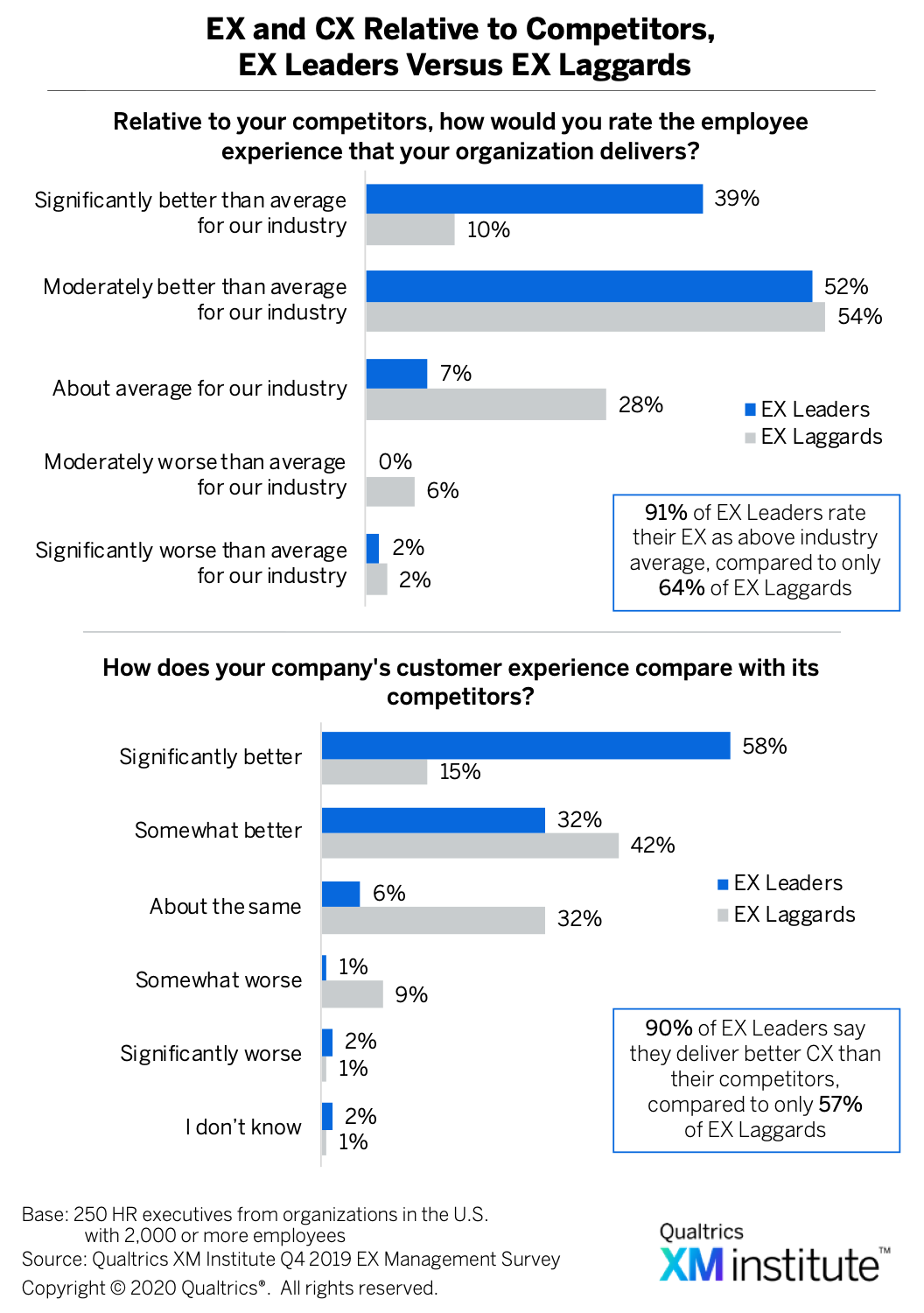 . A similar trend holds for CX delivery, with 58% of EX Leaders saying their CX is “significantly better” than their competitors versus just 15% of EX Laggards.
. A similar trend holds for CX delivery, with 58% of EX Leaders saying their CX is “significantly better” than their competitors versus just 15% of EX Laggards. - Have more coordination with CX efforts. Seventy-eight percent of EX leaders say HR professionals are significantly involved in CX initiatives
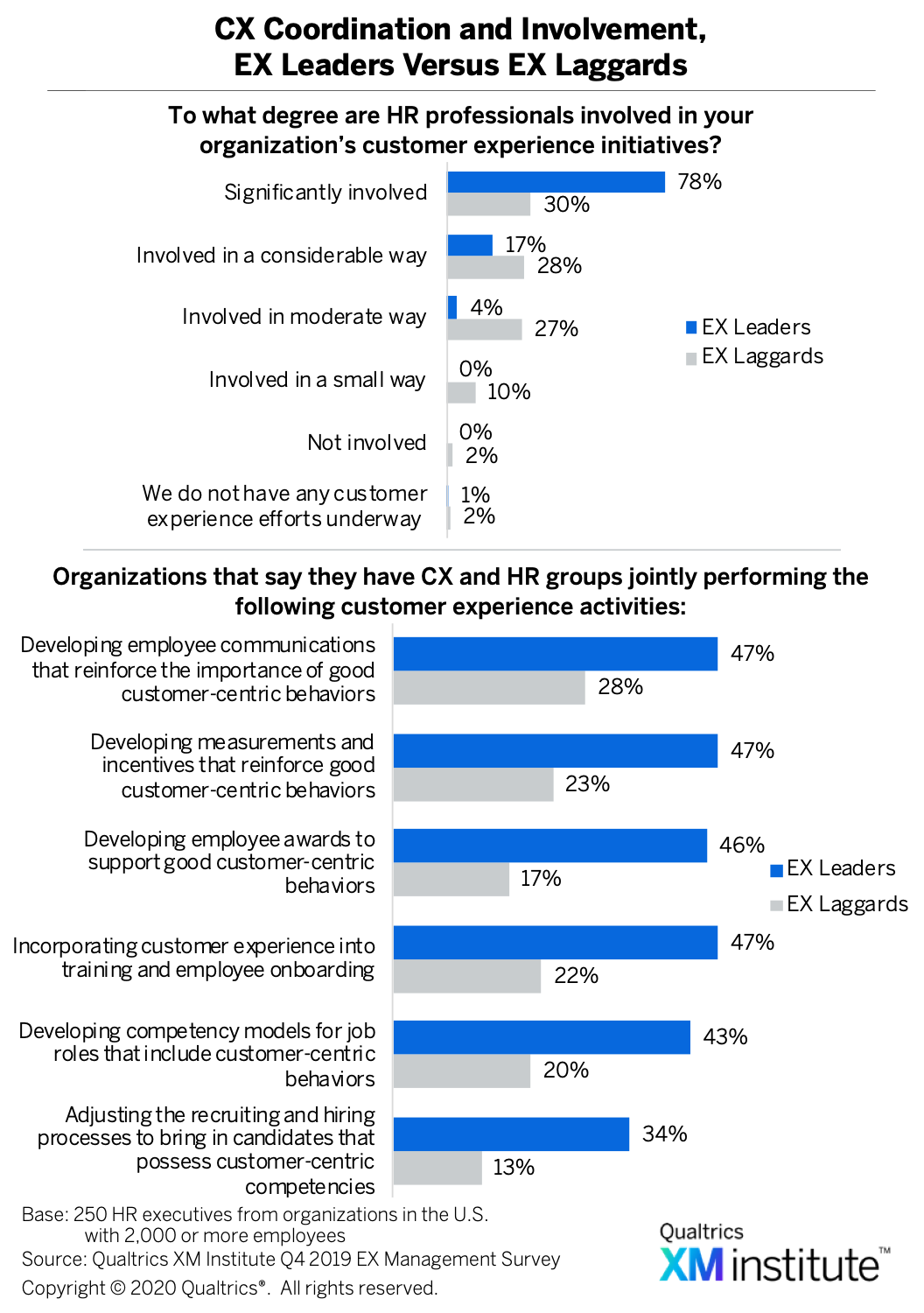 . When it comes to CX and HR groups jointly performing EX activities that influence CX, such as developing employee awards to support good customer-centric behavior, 46% of EX Leaders report this is the case for them compared to only 17% of EX Laggards.
. When it comes to CX and HR groups jointly performing EX activities that influence CX, such as developing employee awards to support good customer-centric behavior, 46% of EX Leaders report this is the case for them compared to only 17% of EX Laggards. - Enjoy more active leadership support. Ninety-four percent of EX Leaders say their CEO or equivalent leader is a strong champion for EX – more than double the percentage of EX Laggards
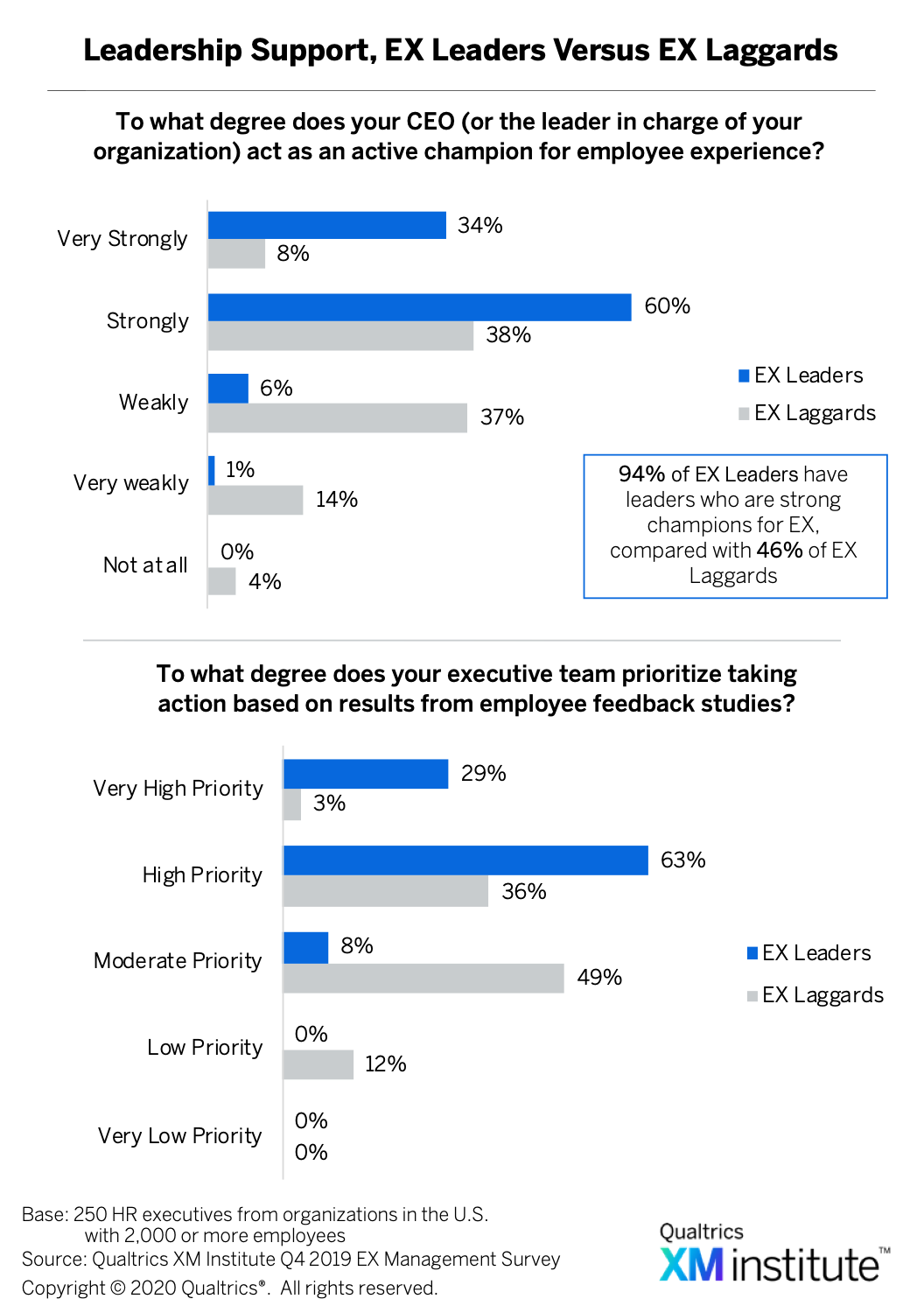 . Similarly, 92% of EX Leaders report that executive teams make taking action on employee feedback a “high” or “very high” priority compared with only 39% of EX Laggards.
. Similarly, 92% of EX Leaders report that executive teams make taking action on employee feedback a “high” or “very high” priority compared with only 39% of EX Laggards. - Collect employee feedback more frequently. Forty-six percent of EX Leaders measure employee engagement more than once a year while only 28% of EX Laggards do the same
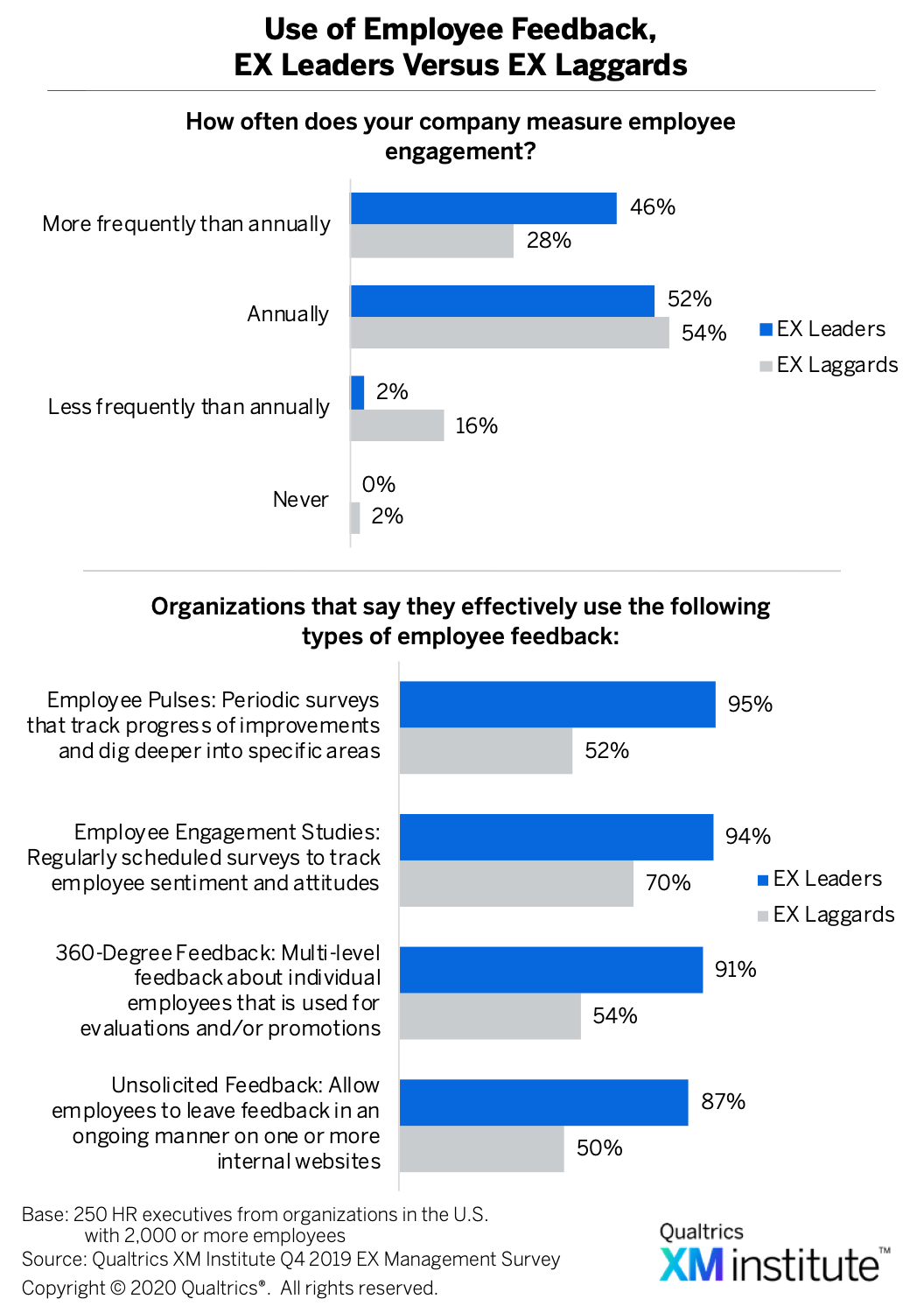 .
. - Use employee feedback more effectively. Employee Pulse has the largest discrepancy in how it is used by EX Leaders and Laggards with 95% of Leaders and 52% of Laggards reporting effective use of Employee Pulse. A similarly sized gap exists for 360-degree and unsolicited feedback.
- Ask for feedback across more employee experiences. A higher proportion of EX Leaders collect feedback after more types of employee experiences than EX Laggards
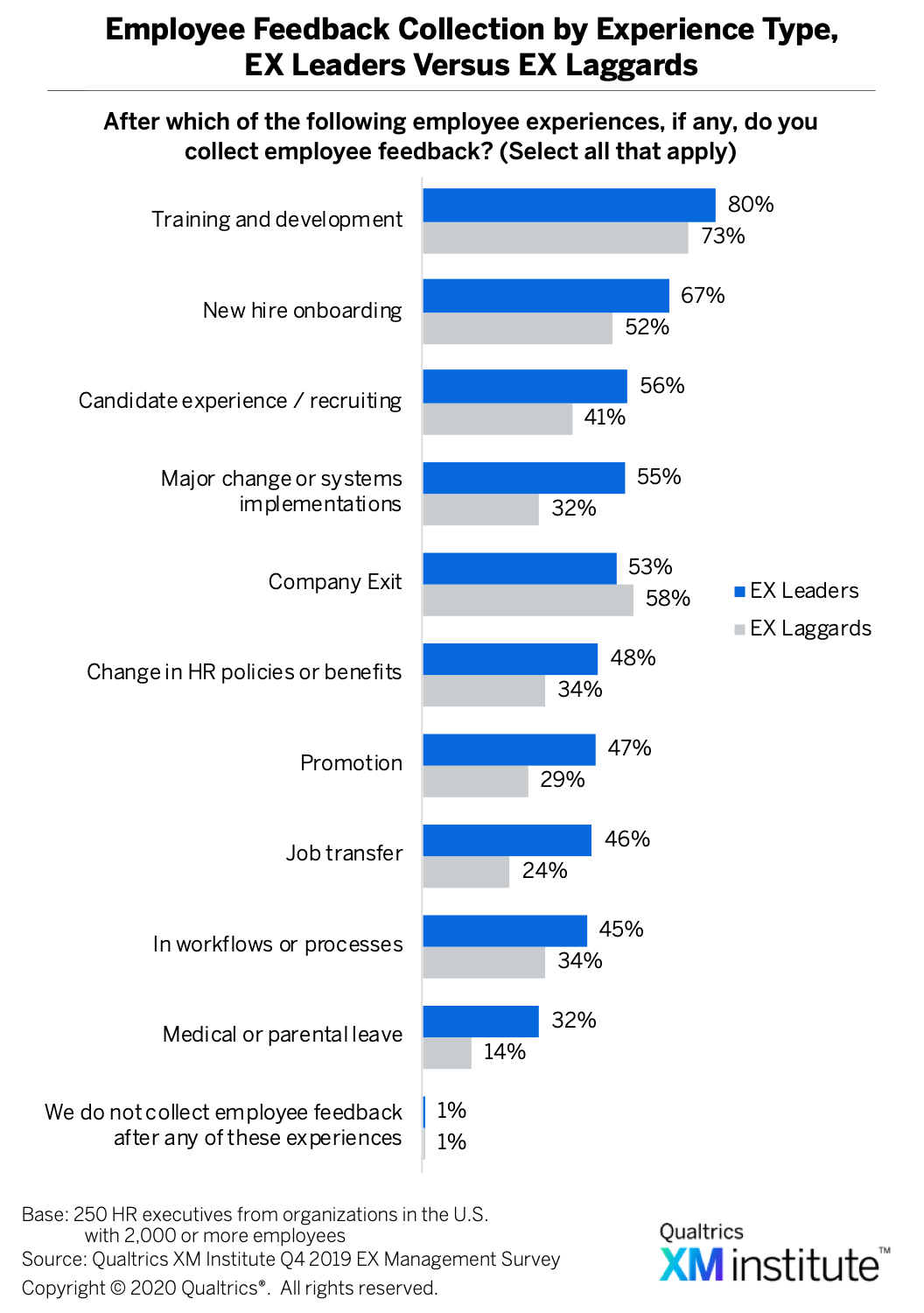 . The only exception is company exit where 58% of EX Laggards collect feedback compared to 53% of EX Leaders.
. The only exception is company exit where 58% of EX Laggards collect feedback compared to 53% of EX Leaders. - Drive improvements across more employee experiences. EX Leaders report effectively making ongoing improvements at a higher rate than EX Laggards in all ten experiences about which we asked. The largest discrepancy was in candidate recruiting/experience where 88% of Leaders and 38% of Laggards say they are effective
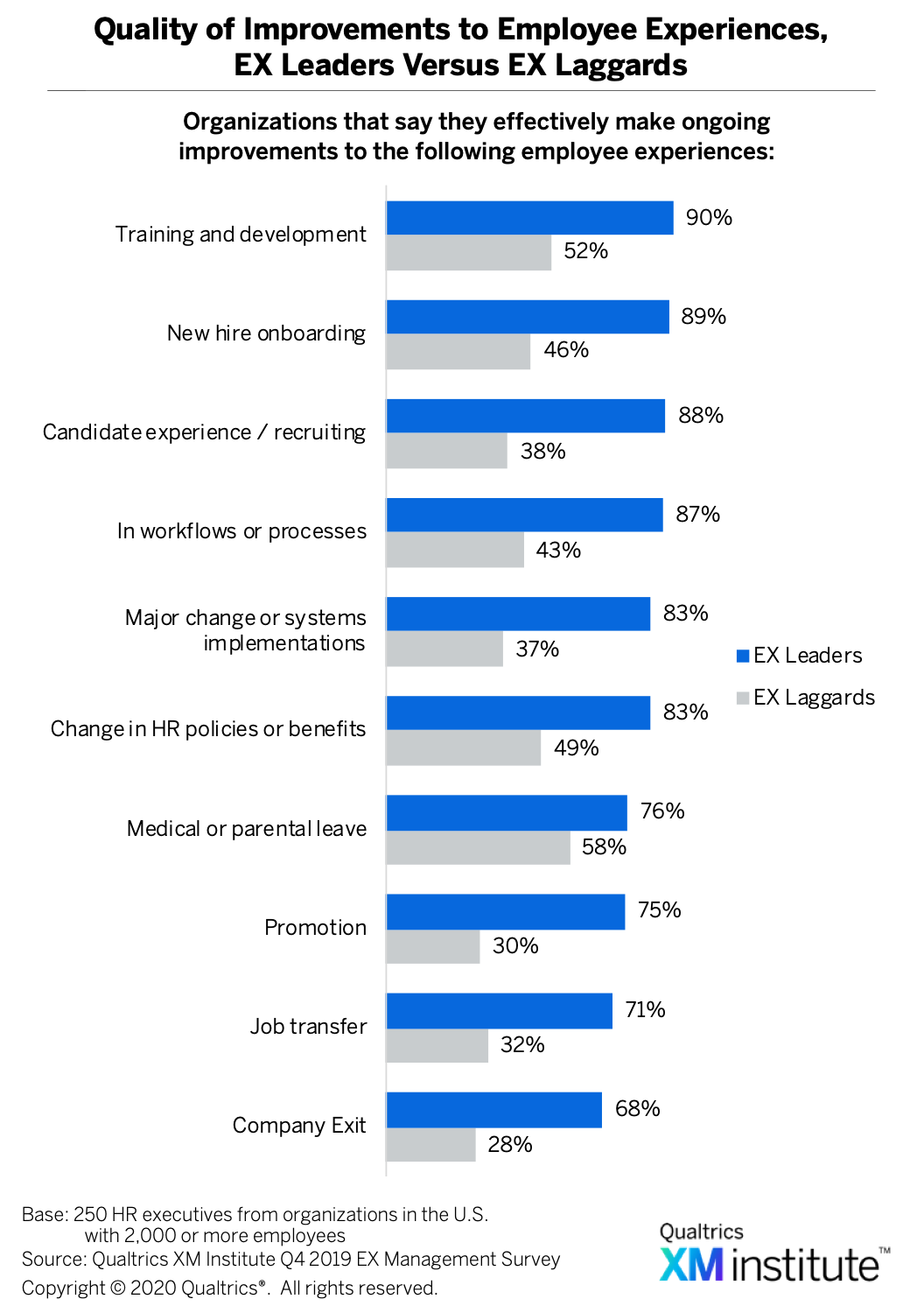 .
. - See more of an issue with inconsistent buy-in. The top obstacles identified by EX Leaders deal with inconsistent buy-in from the leadership team and front-line employees, both of which they highlight more than EX Laggards
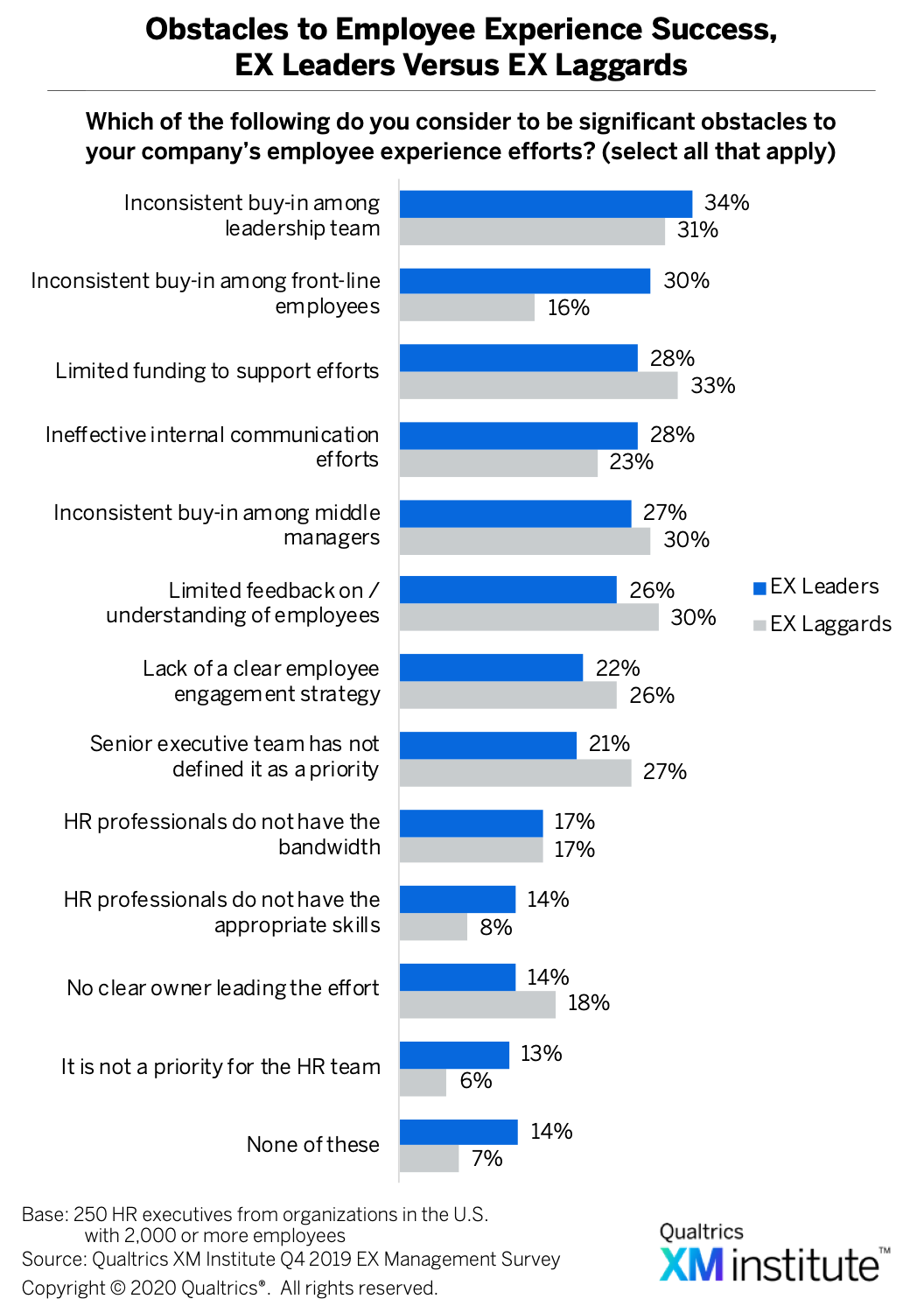 .
.
Assessing Your Employee Experience Competency
As some organizations focus on developing the six XM Competencies more than other organizations, the gap between EX leaders and EX Laggards will grow. To help gauge your organization’s progress on the EX component of its experience management journey, use the Qualtrics XM Institute’s EX Competency & Maturity Assessment for:
- Self-assessments. Take the test yourself and identify the strengths and weaknesses of your organization.
- Group discussions. Have multiple people complete the self-assessment and discuss the results as a group. Talk about the strengths and weaknesses identified as well as the areas of agreement and disagreement in the results.
- Benchmarking. Compare your results to the Qualtrics XM Institute’s data about how other companies perform. We’ve provided a chart you can use to identify how your score compares to the scores of 250 large companies
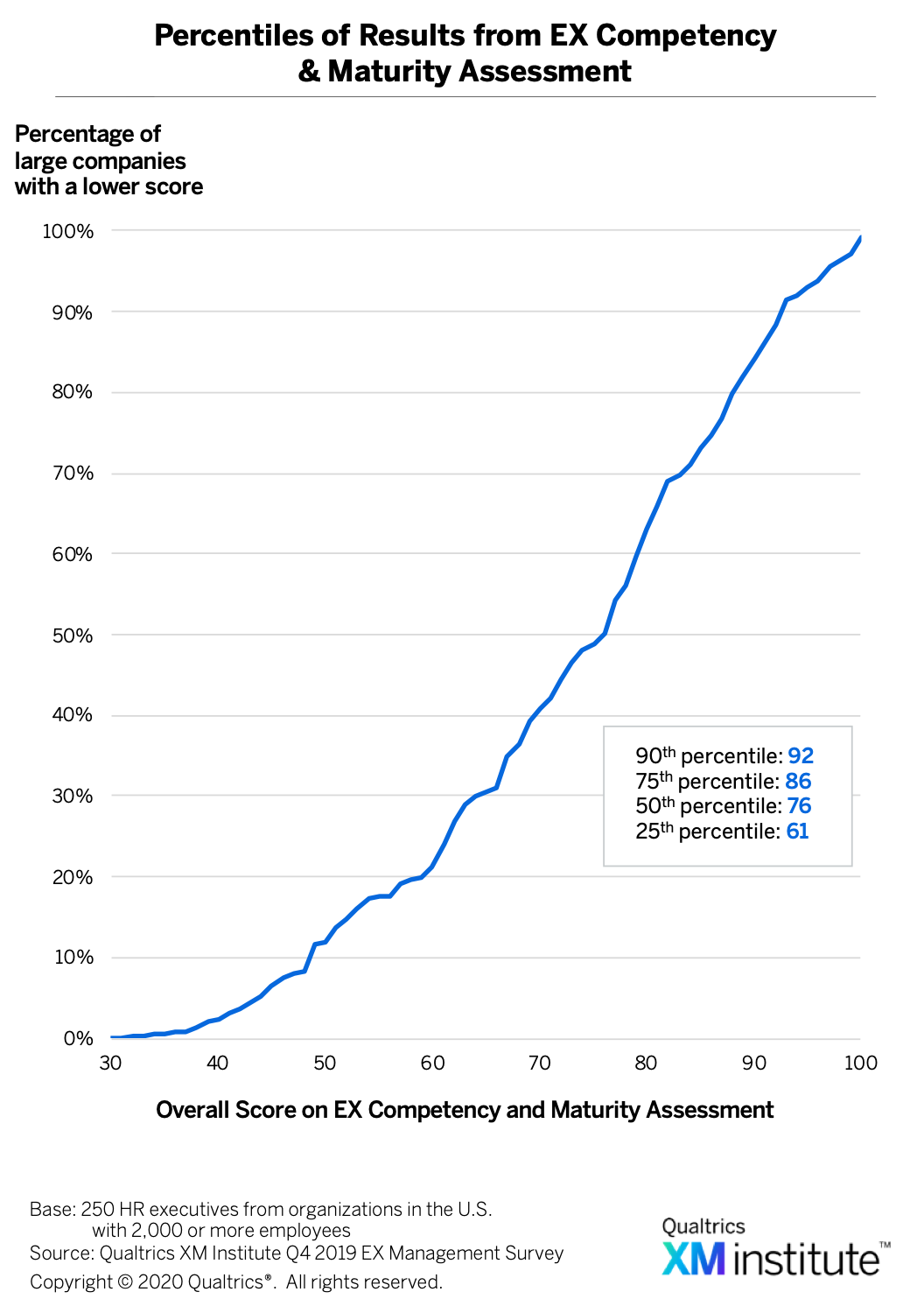 .
. - Action planning. Develop plans for making progress towards mastering EX.
- Progress tracking. Repeat the self-test every six to twelve months to track your progress and identify your key areas of focus. The goal is to drive an ongoing discussion and continue prioritizing EX efforts.
- The Qualtrics XM Institute conducted this survey in June 2019. The data were cleansed to eliminate partial, duplicate, and questionable responses. This report analyzes 250 responses from HR leaders from companies in the U.S. with 2,000 or more employees.
- See the XM Institute Insight Report, “Operationalizing XM,” (July 2019).





